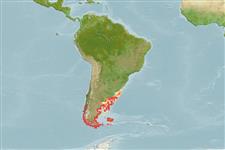Environment: milieu / climate zone / depth range / distribution range
Ecologia
marino benthopelagico; distribuzione batimetrica 0 - 250 m (Ref. 127764). Temperate; 32°S - 57°S, 76°W - 53°W
Southeast Pacific and Southwest Atlantic: Valparaíso, Chile and Patagonian region of Argentina to Tierra del Fuego.
Size / Peso / Age
Maturity: Lm ? range ? - ? cm
Max length : 90.0 cm TL (female); peso massimo pubblicato: 0.00 g
Spine dorsali (totale) : 7 - 8; Raggi dorsali molli (totale) : 23 - 27; Spine anali: 0; Raggi anali molli: 0. Caudal fin emarginate. Body blue brown dorsally and silvery yellow ventrally. First and second dorsal fins grayish, caudal fin brownish, their distal parts yellowish. Anal fin pale brown (Ref. 27363).
Life cycle and mating behavior
Maturità | Riproduzione | Deposizione | Uova | Fecundity | Larve
Corporacion de Fomento de la Produccion (Chile), 1980. Catálogo de recursos pesqueros Chile. Instituto de Fomento Pesquero, Gerencia de Desarollo, CORFO, Santiago, Chile. (Ref. 5964)
IUCN Red List Status (Ref. 130435: Version 2024-2)
Threat to humans
Harmless
Human uses
Pesca: scarso interesse commerciale
Strumenti
Special reports
Download XML
Fonti Internet
Estimates based on models
Preferred temperature (Ref.
123201): 7 - 16.1, mean 10.7 °C (based on 172 cells).
Phylogenetic diversity index (Ref.
82804): PD
50 = 1.5000 [Uniqueness, from 0.5 = low to 2.0 = high].
Bayesian length-weight: a=0.00977 (0.00430 - 0.02222), b=3.06 (2.85 - 3.27), in cm total length, based on LWR estimates for this (Sub)family-body shape (Ref.
93245).
Trophic level (Ref.
69278): 3.5 ±0.41 se; based on food items.
Generation time: 7.8 ( na - na) years. Estimated as median ln(3)/K based on 1
growth studies.
Resilienza (Ref.
120179): Medio, tempo minimo di raddoppiamento della popolazione 1.4 - 4.4 anni (Assuming tm <4).
Fishing Vulnerability (Ref.
59153): High vulnerability (61 of 100).
Climate Vulnerability (Ref.
125649): Very high vulnerability (100 of 100).
Nutrients (Ref.
124155): Calcium = 15.3 [9.6, 26.5] mg/100g; Iron = 0.224 [0.142, 0.358] mg/100g; Protein = 17.9 [17.1, 18.8] %; Omega3 = 0.517 [0.296, 0.895] g/100g; Selenium = 18.6 [9.9, 36.3] μg/100g; VitaminA = 17.4 [5.3, 57.2] μg/100g; Zinc = 0.557 [0.408, 0.774] mg/100g (wet weight);
